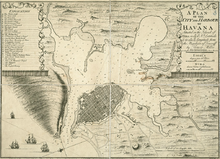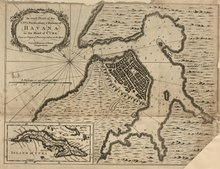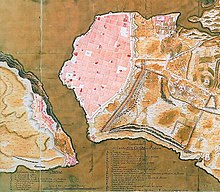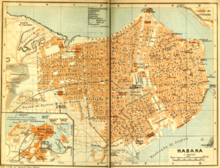Timeline of Havana
The following is a timeline of the history of Havana, Cuba.
Prior to 18th century[]
| History of Cuba |
|---|
 |
| Governorate of Cuba (1511–1519) |
| Viceroyalty of New Spain (1535–1821) |
| Captaincy General of Cuba (1607–1898) |
|
|
| US Military Government (1898–1902) |
| Republic of Cuba (1902–1959) |
|
|
| Republic of Cuba (1959–) |
|
|
| Timeline |
|
|
| Topical |
|
|
- 1515 – Diego Velázquez de Cuéllar founds settlement.
- 1537 – Town sacked.[1]
- 1555 – Town sacked by Jacques de Sores.[2]
- 1577 – Castillo de la Real Fuerza built.
- 1578 – Church of Santo Domingo built.[3]
- 1589 – Governor's residence relocated to Havana from Santiago de Cuba.[1]
- 1591 – Basilica Menor de San Francisco de Asis built.
- 1592 – City status granted.[4]
- 1607 – Havana becomes capital of Cuba.[5]
- 1608 – San Agustin church built.[1]
- 1630 – San Salvador de la Punta Fortress built.[citation needed]
- 1640 – Morro Castle built.[1]
- 1644 – Convent of Santa Clara founded.[4][6]
- 1648 – Epidemic.[4]
- 1668 – construction begins.[citation needed]
- 1688 – Recollect Dominicans of Santa Cataline de Siena founded.[6]
- 1693 – San Felipe church built.[1]
- 1700
18th century[]
- 1702 – City walls built.[1]
- 1704 – Jesuit college built.[1]
- 1728 – Royal and Pontifical University of Saint Jerome established.[7]
 Map of Havana, 1739
Map of Havana, 1739 Plan of Havana, 1758
Plan of Havana, 1758 Map of Havana, 1762
Map of Havana, 1762
 Detail of the plan of the city, port and castles of San Christobal de La Habana-1776
Detail of the plan of the city, port and castles of San Christobal de La Habana-1776
- 1748 – Battle of Havana.
- 1762 – Battle of Havana; British in power.[8]
- 1763 – 6 July: Spanish in power per Treaty of Paris (1763).[9]
- 1767 – Castillo de Atarés built.[3]
- 1768
- 1772 – Paseo del Prado laid out (approximate date).[citation needed]
- 1774 – La Cabaña fortress built.
- 1775 – El Coleseo (theatre) built on the Alameda de Paula.[4]
- 1777 – Cathedral of Havana built.[4]
- 1780 – Castle del Príncipe built.[1]
- 1781 –
- Hospital de San Lazaro, Havana
- 1787 – Roman Catholic diocese of San Cristóbal de la Habana established.[12]
- 1789 – Bishopric established.[1]
- 1791 – Population: 51,307.[1]
- 1792
- Sociedad Económica de los Amigos del País de la Habana established.[7]
- Palace built.[1]
- 1794
- 1799
- Bateria de Santa Clara, 1799 File:Battery of Santa Clara areal. Havana, Cuba.jpg
19th century[]

Map of Habana. 1853

Map of Habana. 1866

Map of Havana, 1888

Map of Havana, 1898

Map of Havana, 2016
- 1806 - Espada Cemetery|
- 1810 – Hurricane.[1]
- 1811 – Population: 94,023.[1]
- 1813 – El Lucero de la Habana newspaper begins publication.
- 1817
- Botanical Gardens established.[14]
- La Piña de Plata eatery in business.
- 1828 – El Templete built in the Plaza de Armas.[1]
- 1832 – El Noticioso y Lucero de la Habana newspaper begins publication.
- 1834 – President's Palace built.[3]
- 1835
- 1837 – Railway (Havana-Bejucal), Mercado de Cristina, and city jail[1] constructed.
- 1838 – Teatro Tacón opens.[4]
- 1840 – Plaza del Vapor
- 1844
- Liceo Artistico y Literario de la Habana (lyceum) founded.[16][17]
- Palacio de Aldama built.[18]
- 1846 – Great Havana Hurricane.
- 1847 – Premiere of Bottesini's opera Cristoforo Colombo.[19]
- 1853
- Susini cigarette factory in operation.[20]
- Revista de la Habana literary magazine begins publication.[4]
- 1854 – Colegio de Belén founded.[7]
- 1856 – Hotel Inglaterra built.[14]
- 1861 – Royal Academy of Medical, Physical, and Natural Sciences established.[7][21]
- 1863
- Fuente de la India (fountain) installed in Parque Central.
- City walls dismantled.
- 1868
- El Ansador Comercial begins publication.[1]
- Colon Cemetery inaugurated.[22]
- 1871 – 27 November: Students executed.[3](es)
- 1876 – Hotel Pasaje built.[23]
- 1877
- 1878
- Acueducto de Albear inaugurated.
- City becomes part of La Habana Province.
- 1880 – Colegio de Abogados de La Habana (bar association) founded.[7]
- 1881 – Jane Theater-Circus built.[14]
- 1882 – School of arts and trades opens.[1]
- 1884 – La Lucha newspaper begins publication.[1]
- 1888 – La Discusion newspaper begins publication.[1]
- 1889 – Population: 200,000.[25]
- 1890 – Alhambra Theatre opens.[26]
- 1894 – Manzana de Gómez built.[14]
- 1898 – 15 February: United States Navy Ship Maine explosion.[27]
- 1899 – U.S. military occupation begins.[1]
20th century[]

Map of Havana, 1909
1900s–1940s[]
- 1901
- Biblioteca Nacional José Martí (library) established.[1]
- Malecón (esplanade) construction begins.
- 1902
- 1905 – Petroleum refinery in operation.[1]
- 1907
- 1908
- Partido Independiente de Color (political party) founded in Havana.[29]
- Bohemia magazine begins publication.[30]
- Hotel Sevilla built.
- 1909 – Lonja del Comercio building (stock exchange) and constructed.[14]
- 1910 – Pimp Alberto Yarini is killed in the San Isidro barrio of Old Havana.
- 1913
- National Museum of Fine Arts of Havana founded.
- El Heraldo de Cuba newspaper begins publication.[31]
- 1917
- Manzana de Gómez shopping arcade built.[4]
- Club Atenas organized.[29]
- 1919
- Florida West Indies Airways begins flights to/from Key West, USA.[20]
- Population: 363,506 city; 697,583 province.[32]
 La Casa de Beneficencia y Maternidad during cyclone of 1919 with the statute of Antonio Maceo in the background.
La Casa de Beneficencia y Maternidad during cyclone of 1919 with the statute of Antonio Maceo in the background.
- 1920
- 1923 – built.
- 1925 Colegio de Belen, designed by Leonardo Morales y Pedroso is built.
- 1927 – Regina Theatre[26] and Centro Asturiano open.[14]
- 1928
- January–February: Pan-American Conference held in Havana.
- [[Parque de la Fraternidad Americana|es]] (park) and Teatro Auditorium[4] inaugurated.
- 1929 – National Capitol Building constructed.[4]
- 1930
- Hotel Nacional de Cuba opens.
- Rancho Boyeros Airport begins operating.
- Bacardi Building constructed.[35]
- 1934 – Orquesta de Cámara de La Habana (musical group) formed.[30]
- 1938 – created; becomes city historian.[36]
- 1939
- Tropicana Club in business.
- Cuban Baseball Hall of Fame inaugurated.
- Lyceum and Lawn Tennis Club formed.[34]
- 1945 – International Air Transport Association founded in Havana.
- 1946
- Havana Conference held.
- Manuel Fernandez Supervielle becomes mayor.[citation needed]
- 1947
- 1948 – Cuban National Ballet founded.
1950s–1990s[]
- 1953 – Iglesia de Jesús de Miramar (church) and Embassy of the United States built.
- 1956 – FOCSA Building.
- 1957
- 13 March: Presidential Palace Attack.
- building constructed on Plaza Cívica.[10]
- Coliseo de la Ciudad Deportiva (arena) opens.
- 1958
- November: Rafael Guas Inclán elected mayor.
- José Martí Memorial erected in Plaza Cívica.
- 1958 Cuban general election
- Andrés Rivero Agüero is the last democratically elected president of Cuba under the 1940 Constitution.
- 1959
- January: Revolutionary forces take city.[37]
- Instituto Nacional de Ahorro y Vivienda (housing agency) headquartered in Havana.[38]
- Plaza del Vapor demolished by the Castro government.[39]
- Plaza Cívica renamed "Plaza de la Revolución".
- 1960 – International Ballet Festival of Havana begins.
- 1961
- Cuban Ministry of the Interior headquartered in Havana.
- Instituto Tecnico Militar established.
- 1962 – Cuban National Ballet School established.
- 1963 – Cuban Journalists Union headquartered in Havana.[40]
- 1964
- Jaime Lucas Ortega y Alamino becomes Catholic archbishop of Havana.
- Population: 940,700 city; 1,517,700 urban agglomeration.[41]
- 1965
- in use as headquarters of the Communist Party.
- International School of Havana established.
- 1968 – (garden) established.[42]
- 1970 - Population: 1,008,500 city; 1,751,216 urban agglomeration.[43]
- 1971 – Danza Contemporanea de Cuba active.
- 1975 – December: 1st Congress of the Communist Party of Cuba held in Havana.
- 1976 – Arroyo Naranjo, Boyeros, Centro Habana, Cerro, Cotorro, Diez de Octubre, Guanabacoa, La Habana del Este, La Habana Vieja, La Lisa, Marianao, Playa, Plaza de la Revolución, Regla, San Miguel del Padrón administrative municipalities created.
- 1977 – 's Editorial Letras Cubanas publishing house headquartered in Havana.[40]
- 1978 – City hosts World Festival of Youth and Students.
- 1979
- Havana Film Festival begins.
- built.
- 1982
- Old Havana designated an UNESCO World Heritage Site.[5]
- Havana International Book Fair begins.
- 1983 – headquartered in Havana.
- 1984 – Havana Biennial Art Exhibition begins.
- 1987
- Grupo para el Desarrollo Integral de la Capital (urban planning group) formed.[10]
- Russian embassy built.[44]
- Instituto de Historia de Cuba headquartered in Havana.
- 1991
- Estadio Panamericano (stadium) opens.
- 1991 Pan American Games held in Havana.
- 1993 - Population: 2,175,888 city (estimate).[45]
- 1994
- August 1994 protest in Cuba.
- Bán Rarra group active.[46]
- Meliá Cohiba Hotel in business.
- 1998 – January: Catholic Pope visits Havana.
- 1999 – Population: 2,189,716 city; 2,891,500 province.[40]
21st century[]
- 2001 – Ballet Rakatan founded.
- 2003
- Damas de Blanco protest begins.
- Juan Contino Aslán becomes mayor.[47]
- 2005 – December: World Trade Union Congress held in city.[48]
- 2011
- April: 6th Congress of the Communist Party of Cuba held in Havana.
- Marta Hernández Romero becomes mayor.
- 2012 – Population: 2,105,291.[49]
- 2014
- Fábrica de Arte Cubano cultural space established.
- Population: 2,121,871.[50]
- 2015
- January: United States–Cuban talks held in Havana.[37][51]
- September: Catholic pope visits city.[52]
- 2016
- March: U.S. president Obama visits Havana.
- April: 7th Congress of the Communist Party of Cuba held in Havana.
- 2019
- Havana's celebrates its 500th Anniversary of founding.[53]
See also[]
- History of Havana
- Timeline of Cuban history
- Timelines of other cities in Cuba: Camagüey, Cienfuegos, Guantánamo, Holguín, Matanzas, Santiago de Cuba
References[]
- ^ Jump up to: a b c d e f g h i j k l m n o p q r s t u v w x y z aa ab Britannica 1910.
- ^ "Cuba". Political Chronology of the Americas. Europa Publications. 2001. ISBN 978-1-85743-118-6.
- ^ Jump up to: a b c d Baedeker 1909.
- ^ Jump up to: a b "Old Havana and its Fortification System". World Heritage Centre. United Nations Educational, Scientific and Cultural Organization. Retrieved 1 June 2015.
- ^ Jump up to: a b c John James Clune (2001). "A Cuban Convent in the Age of Enlightened Reform: The Observant Franciscan Community of Santa Clara of Havana, 1768–1808". The Americas. 57.
- ^ Jump up to: a b c d e f "Cuba". Handbook of Learned Societies and Institutions: America. USA: Carnegie Institution of Washington. 1908.
- ^ "Timelines: History of Cuba from 1492 to 2008", World Book, USA
- ^ Morse 1797.
- ^ Jump up to: a b c Scarpaci et al. 2002.
- ^ "Chronology of Catholic Dioceses: Cuba". Norway: Roman Catholic Diocese of Oslo. Retrieved 1 June 2015.
- ^ Ralph Lee Woodward Jr. (2013) [2005], "Merchant Guilds", in Cynthia Clark Northrup (ed.), Encyclopedia of World Trade, Routledge, ISBN 9780765682680
- ^ Jump up to: a b c d e f g h i Lejeune 1996.
- ^ Barclay 1993.
- ^ Ramírez 1891.
- ^ (1944), Catálogo de los fondos del Liceo Artístico y Literario de la Habana (in Spanish), Archivo Nacional de la República de CubaCS1 maint: multiple names: authors list (link)
- ^ Philippou 2014.
- ^ Robert Murrell Stevenson (1992), "Havana", New Grove Dictionary of Opera, New York, ISBN 0935859926
- ^ Jump up to: a b Patrick Robertson (2011). Robertson's Book of Firsts. Bloomsbury. ISBN 978-1-60819-738-5.
- ^ Pedro M. Pruna (1994). "National Science in a Colonial Context: The Royal Academy of Sciences of Havana, 1861–1898". Isis. 85 (3): 412–426. doi:10.1086/356890. JSTOR 235461.
- ^ Bankers' Loan and Securities Company, New Orleans (1916), The Republic of Cuba, New Orleans, OL 22892116M
- ^ Fornias 1996.
- ^ Waldo Jiménez de la Romera (1887), Cuba, Puerto-Rico y Filipinas (in Spanish), Barcelona: D. Cortezo y ca., OCLC 3153821
- ^ Karl August Zehden (1889), Commercial Geography, London: Blacke & Son, Limited
- ^ Jump up to: a b Susan Thomas (2008), Cuban Zarzuela: Performing Race and Gender on Havana's Lyric Stage, University of Illinois Press, ISBN 9780252033315, OL 10227809M, 0252033310
- ^ "On This Day", New York Times, retrieved 1 June 2015
- ^ Kirwin R. Shaffer (2009). "Havana Hub: Cuban Anarchism, Radical Media and the Trans-Caribbean Anarchist Network, 1902–1915". Caribbean Studies. 37 (2): 45–81. doi:10.1353/crb.2010.0018. JSTOR 25702369.
- ^ Jump up to: a b Kwame Anthony Appiah; Henry Louis Gates, eds. (2005). Africana: The Encyclopedia of the African and African American Experience (2nd ed.). Oxford University Press. ISBN 978-0-19-517055-9.
- ^ Jump up to: a b Daniel Balderston; Mike Gonzalez; Ana M. Lopez, eds. (2000). Encyclopedia of Contemporary Latin American and Caribbean Cultures. Routledge. ISBN 978-1-134-78852-1.
- ^ Sanger 1919.
- ^ "Cuba". Statesman's Year-Book. London: Macmillan and Co. 1921.
- ^ Miguel Viciedo Valdés (2005), "Breve reseña sobre la biblioteca pública en Cuba antes de 1959", Acimed (in Spanish), Havana: Centro Nacional de Informacion de Ciencias Medicas, 14 (1), ISSN 1024-9435
- ^ Jump up to: a b "Cuban Heritage Collection". University of Miami Libraries. Retrieved 14 January 2013.
- ^ "Mexico and Central America, 1900 A.D.: Key Events". Heilbrunn Timeline of Art History. New York: Metropolitan Museum of Art. Retrieved 1 May 2014.
- ^ "Oficina del Historiador" (in Spanish). Havana: Dirección de Patrimonio Cultural. Retrieved 3 October 2016.
- ^ Jump up to: a b "Cuba Profile: Timeline", BBC News, retrieved 1 September 2015
- ^ Ruslan Muñoz Hernández; Gabriela González González (2015). "Labor desarrollada por el Instituto Nacional de Ahorro y Vivienda (INAV) en La Habana (1959–1962)" [The Work of the National Institute of Savings and Housing (INAV) in Havana (1959–1962)]. Revista INVI (in Spanish). Chile. 30 (84): 89–120. doi:10.4067/S0718-83582015000200004.
- ^ "Los proyectos inconclusos o fracasados de Fidel Castro". Retrieved 2020-01-18.
- ^ Jump up to: a b c South America, Central America and the Caribbean 2002. Regional Surveys of the World. Europa Publications. 2001. ISBN 978-1-85743-121-6.
- ^ "Population of capital cities and cities of 100,000 and more inhabitants". Demographic Yearbook 1965. New York: Statistical Office of the United Nations. 1966.
- ^ "Garden Search: Cuba". London: Botanic Gardens Conservation International. Retrieved 1 September 2015.
- ^ United Nations Department of Economic and Social Affairs, Statistical Office (1976). "Population of capital city and cities of 100,000 and more inhabitants". Demographic Yearbook 1975. New York. pp. 253–279.
- ^ "Demolition dreams: the world's 'worst' buildings", Financial Times, 31 October 2014
- ^ United Nations Department for Economic and Social Information and Policy Analysis, Statistics Division (1997). "Population of capital cities and cities of 100,000 and more inhabitants". 1995 Demographic Yearbook. New York. pp. 262–321.
- ^ Rebecca M. Bodenheimer (2015). Geographies of Cubanidad: Place, Race, and Musical Performance in Contemporary Cuba. USA: University Press of Mississippi. ISBN 978-1-62674-684-8.
- ^ "El alcalde invisible". El Mundo (in Spanish). Spain. 2 November 2009.
- ^ Richard Green (2004). Chronology of International Organizations. Routledge. ISBN 978-1-135-35590-6.
- ^ "Population of Capital Cities and Cities of 100,000 or More Inhabitants". Demographic Yearbook 2013. United Nations Statistics Division.
- ^ "Population of Capital Cities and Cities of 100,000 or More Inhabitants". Demographic Yearbook 2014. United Nations Statistics Division.
- ^ "Chronicle of 2015", Annual Register (257 ed.), UK, 2016, ISSN 0266-6170
- ^ "Cuba: Pope Francis celebrates Mass before thousands", BBC News, 20 September 2015
- ^ Staff writer (19 April 2019). "Culture celebrates Havana's 500th Anniversary". The United Nations Educational, Scientific and Cultural Organization (UNESCO). Retrieved 20 March 2021.
This article incorporates information from the Spanish Wikipedia.
Bibliography[]
Published in the 18th–19th century[]
- in English
- Jedidiah Morse (1797), "Havannah", The American Gazetteer, Boston: S. Hall, and Thomas & Andrews
- R. H. Bonnycastle (1819). "Havannah". Spanish America. Philadelphia: A. Small.
- C. D. Tyng (1868), The Stranger in the Tropics: Being a Hand-book for Havana, New York: American News Co.
- George Henry Townsend (1877), "Havana", A Manual of Dates (5th ed.), London: Frederick Warne & Co.
- Charles Morris (1899), "Havana", Our Island Empire: a Hand-book of Cuba, Porto Rico, Hawaii, and the Philippine Islands, Philadelphia: J.B. Lippincott Company, OCLC 541085
- Abel Linares (1899). Cuba, an illustrated guide book on the island. Havana: Wilson's International Book Store.
- Jose de Olivares (1899), "Havana: the Key of the New Possessions", Our Islands and Their People as Seen with Camera and Pencil, 1, USA: N.D. Thompson, pp. 19–32 – via Internet Archive
- Albert James Norton (1900), Norton's Complete Hand-book of Havana and Cuba, Chicago: Rand, McNally & Co., OCLC 4617287, OL 13488445M
- in Spanish
- Ordenanzas municipales de la ciudad de La Habana (in Spanish). Imprenta del gobierno y capitania general. 1855.
- José María de la Torre (1857). Lo que fuimos y lo que somos, o, La Habana antiqua y moderna [Havana, Past and Present] (in Spanish). Spencer y Compania.
- Jacobo de la Pezuela (1863). "Habana: Historia". Diccionario geografico, estadístico, historico, de la isla de Cuba (in Spanish). 3. Madrid: Mellado – via HathiTrust. (chronology)
- "Profesiones de la Isla de Cuba: Provincia de la Habana", Directorio Hispano-Americano (in Spanish), Habana: Caine y Carricaburu, 1879 – via HathiTrust
- Serafín Ramírez (1891). La Habana Artística: Apuntes Históricos (in Spanish). Habana: Capitania General.
Published in the 20th century[]
- in English
- "Havana". Chambers's Encyclopaedia. London. 1901.
- José Toribio Medina (1904). La imprenta en La Habana (1707–1810) (in Spanish). Santiago de Chile: Imprenta Elzeviriana – via HathiTrust. (Annotated list of titles published in Havana, arranged chronologically)
- "Havana", The United States, with Excursions to Mexico, Cuba, Porto Rico, and Alaska (4th ed.), Leipzig: K. Baedeker, 1909
- Charles B. Reynolds (1909), "Havana", Standard Guide to Cuba, Havana: Foster & Reynolds, OCLC 21914222
- "Havana", Encyclopædia Britannica (11th ed.), New York: New York : Encyclopaedia Britannica, 1910, OCLC 14782424 – via Internet Archive
- Benjamin Vincent (1910), "Havana", Haydn's Dictionary of Dates (25th ed.), London: Ward, Lock & Co. – via Hathi Trust
- New York Public Library (1912). "Cuba: History and Description: Havana (City)". List of Works Relating to the West Indies. USA. pp. 170–74.
- J.W. Sanger (1919), "Publications in Habana", Advertising Methods in Cuba, Special Agents Series, Washington DC: United States Department of Commerce
- U.S. Merchant Marine, Social Service Bureau (1920). "Havana, Cuba". Seaman's Handbook for Shore Leave (2nd ed.). Boston: Custom House.
- Walker Evans: Havana 1933. Thames and Hudson. 1989.
- Juliet Barclay (1993). Havana: Portrait of a City. Cassell Illustrated. ISBN 978-1-84403-127-6.
- Sergio Díaz-Briquets (1994). "Cuba". In Gerald Michael Greenfield (ed.). Latin American Urbanization: Historical Profiles of Major Cities. Greenwood Press. pp. 173–87. ISBN 0313259372. (Includes profile of Havana)
- Trudy Ring and Robert M. Salkin, ed. (1995). "Havana". Americas. International Dictionary of Historic Places. Routledge. pp. 279+. ISBN 978-1-134-25930-4.
- Jean-François Lejeune, John Beusterien and Narciso G. Menocal (1996). "The City as Landscape: Jean Claude Nicolas Forestier and the Great Urban Works of Havana, 1925–1930". Journal of Decorative and Propaganda Arts. 22. ISSN 2326-4632.
- Carlos Venegas Fornias, Narciso G. Menocal and Edward Shaw (1996). "Havana between Two Centuries". Journal of Decorative and Propaganda Arts.
- in Spanish
- "Gremios de la Habana", Directorio mercantil de la Isla de Cuba (in Spanish), Habana: Imprenta 'Avisador Comercial', 1901 – via HathiTrust + Directoria de las calles de la Habana (etc.)
- "Republica Cubana: Habana". Anuario del comercio, de la industria, de la magistratura y de la administracion de España, sus colonias, Cuba, Puerto-Rico y Filipinas, estados hispano-americanos y Portugal (in Spanish). 4. Madrid: Bailly-Bailliere e Hijos. 1908. pp. 14–220.
- Eusebio Leal Spengler (1988). La Habana, ciudad antigua (in Spanish). Editorial Letras Cubanas.
Published in the 21st century[]
- in English
- Joseph L. Scarpaci; ; Mario Coyula (2002). Havana: Two Faces of the Antillean Metropolis (Revised ed.). University of North Carolina Press. ISBN 0807827002.CS1 maint: multiple names: authors list (link)
- Joseph L. Scarpaci (2002). "Havana: the dynamics of local executive power". In David J. Myers; Henry A. Dietz (eds.). Capital City Politics in Latin America: Democratization and Empowerment. Lynne Rienner. ISBN 978-1-58826-040-6.
- Mario Coyula Cowley; Jill Hamberg (2003). "The Case of Havana, Cuba". Understanding Slums: Case Studies for the Global Report 2003. United Nations Human Settlements Programme and University College London.
- Antoni Kapcia (2005). Havana: The Making of Cuban Culture. Bloomsbury. ISBN 978-1-85973-837-5.
- Luc J. A. Mougeot, ed. (2005). "(Havana)". Agropolis: The Social, Political, and Environmental Dimensions of Urban Agriculture. International Development Research Centre. ISBN 978-1-55250-186-3.
- Dick Cluster; Rafael Hernández (2006). The History of Havana. Palgrave Macmillan. ISBN 978-0-230-60397-4.
- Alfredo José Estrada (2007). Havana: Autobiography of a City. St. Martin's Press. ISBN 978-1-250-11466-2.
- Anke Birkenmaier; Esther Katheryn Whitfield, eds. (2011). Havana Beyond the Ruins: Cultural Mappings After 1989. Duke University Press. ISBN 9780822350521.
- Matthew J. Hill (2012). "Future of the Past: World Heritage, National Identity, and Urban Centrality in Late Socialist Cuba". In Marina Peterson; Gary McDonogh (eds.). Global Downtowns. City in the Twenty-First Century. University of Pennsylvania Press. ISBN 978-0-8122-0805-4.
- Adriana Premat (2012). Sowing change: the making of Havana's urban agriculture. Nashville: Vanderbilt University Press. ISBN 9780826518583.
- Michael J. Totten (Spring 2014), "The Last Communist City: a Visit to the Dystopian Havana that Tourists Never See", City Journal, New York
- Francisco Sùrez Viera (2014). "Port of Havana: The Gateway of Cuba (1850-1920)". In Miguel Bosa Suirez (ed.). Atlantic Ports and the First Globalisation c. 1850–1930. Palgrave Macmillan. ISBN 978-1-137-32798-7.
- Guadalupe Garcia (2015). Beyond the Walled City: Colonial Exclusion in Havana. University of California Press. ISBN 978-0-520-96137-1.
- Naomi Larsson (5 September 2016), "Havana's dirty truths", The Guardian, Cities
- Helen F. Wilson (2016). "Encountering Havana: texts, aesthetics and documentary encounters". In Jonathan Darling; Helen F. Wilson (eds.). Encountering the City: Urban Encounters from Accra to New York. Routledge. p. 203+. ISBN 978-1-317-14395-6.
- in Spanish
- Leopoldo Fornés Bonavía (2003). Cuba, cronología: cinco siglos de historia, política y cultura (in Spanish). Madrid: . ISBN 978-84-7962-248-0. (chronology)
- Lilian B. Vizcaino Gonzalez (2003). "La Habana (Provincia/Ciudad)". In Louis A. Pérez; Rebecca Jarvis Scott (eds.). The Archives of Cuba: Los Archivos de Cuba (in Spanish). University of Pittsburgh Press. pp. 13–65. ISBN 0822941953.

- Gabino Ponce Herrero (2007). "Crisis, posmodernidad y planificación estratégica en La Habana" [Crisis, postmodernity and strategic planning in Havana]. Anales de Geografía (in Spanish). Complutense University of Madrid. 27. ISSN 1988-2378.

- (2014). Ciudades en el Caribe: un estudio comparado de La Habana, San Juan, Santo Domingo y Miami (in Spanish). Mexico: Latin American Social Sciences Institute. ISBN 978-607-9275-36-5.CS1 maint: multiple names: authors list (link)
- Styliane Philippou (2014), "La Habana del siglo xix: 'Todo lo sólido se desvanece en el aire'" (PDF), Revista Quiroga (in Spanish) (5), ISSN 2254-7037 – via University of La Rioja, Dialnet (bibliographic database)

External links[]
| Wikimedia Commons has media related to History of Havana. |
- "(Havana)" – via Digital Library of the Caribbean.
- "Historical Maps of the Americas: Havana". Perry–Castañeda Library Map Collection. USA: University of Texas at Austin.
- "Havana", American Geographical Society Library Digital Map Collection, USA – via University of Wisconsin, ca. 1849–2005
- Items related to Havana, various dates (via Digital Public Library of America)
- Items related to Havana, various dates (via Europeana)
- Images of Havana, various dates (via New York Public Library)
- "Buenas Prácticas: Cuba". Biblioteca Ciudades para un Futuro más Sostenible (Library: Cities for a Sustainable Future) (in Spanish). Superior Technical School of Architecture of Madrid. (includes articles about Havana)
Coordinates: 23°08′N 82°23′W / 23.13°N 82.38°W
Categories:
- History of Havana
- Timelines of cities in North America
- Cuba-related lists
- Years in Cuba
- Timelines of capitals





